NURSING 101: Search Strategy for Patient Safety and Healthcare Errors
VerifiedAdded on 2022/12/20
|7
|1419
|94
Homework Assignment
AI Summary
This assignment, completed by a nursing student, focuses on developing a search strategy to address healthcare errors, specifically those arising from language barriers and cultural incompetence. The student identifies a patient, Druhi Neupane, a non-English speaking patient, and explains the risks she faces in a hospital setting. The assignment then formulates a research question exploring how language interpretation, communication strategies, and cultural competence impact error susceptibility. A ProQuest database search strategy is detailed, including keywords and Boolean operators, leading to the selection of five relevant articles published between 2015 and 2019. Each article is critically analyzed for its relevance to the research question, highlighting how language barriers and cultural differences contribute to misdiagnosis, maltreatment, and disparities in healthcare. The assignment concludes with a Harvard reference list of the cited articles.
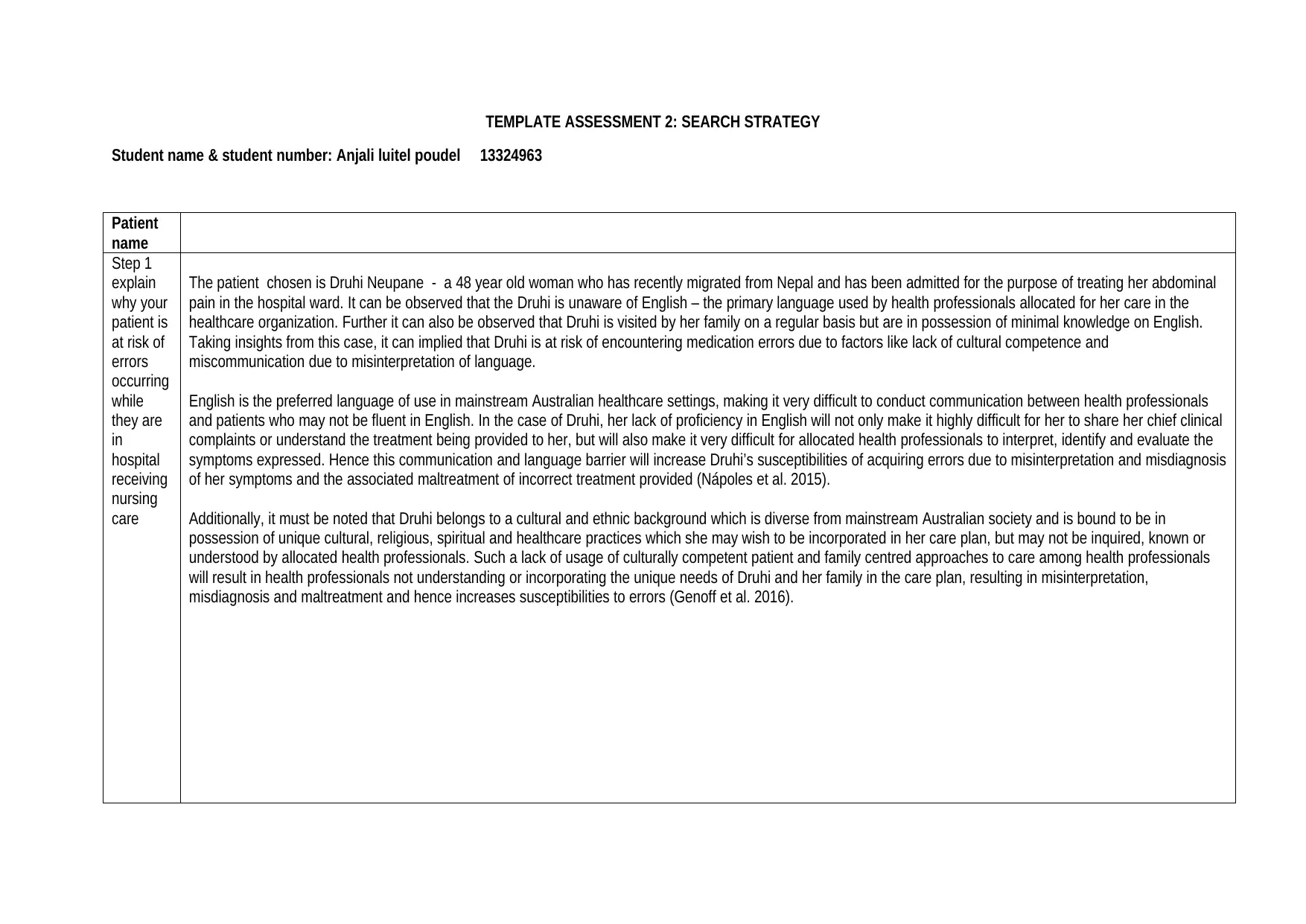
TEMPLATE ASSESSMENT 2: SEARCH STRATEGY
Student name & student number: Anjali luitel poudel 13324963
Patient
name
Step 1
explain
why your
patient is
at risk of
errors
occurring
while
they are
in
hospital
receiving
nursing
care
The patient chosen is Druhi Neupane - a 48 year old woman who has recently migrated from Nepal and has been admitted for the purpose of treating her abdominal
pain in the hospital ward. It can be observed that the Druhi is unaware of English – the primary language used by health professionals allocated for her care in the
healthcare organization. Further it can also be observed that Druhi is visited by her family on a regular basis but are in possession of minimal knowledge on English.
Taking insights from this case, it can implied that Druhi is at risk of encountering medication errors due to factors like lack of cultural competence and
miscommunication due to misinterpretation of language.
English is the preferred language of use in mainstream Australian healthcare settings, making it very difficult to conduct communication between health professionals
and patients who may not be fluent in English. In the case of Druhi, her lack of proficiency in English will not only make it highly difficult for her to share her chief clinical
complaints or understand the treatment being provided to her, but will also make it very difficult for allocated health professionals to interpret, identify and evaluate the
symptoms expressed. Hence this communication and language barrier will increase Druhi’s susceptibilities of acquiring errors due to misinterpretation and misdiagnosis
of her symptoms and the associated maltreatment of incorrect treatment provided (Nápoles et al. 2015).
Additionally, it must be noted that Druhi belongs to a cultural and ethnic background which is diverse from mainstream Australian society and is bound to be in
possession of unique cultural, religious, spiritual and healthcare practices which she may wish to be incorporated in her care plan, but may not be inquired, known or
understood by allocated health professionals. Such a lack of usage of culturally competent patient and family centred approaches to care among health professionals
will result in health professionals not understanding or incorporating the unique needs of Druhi and her family in the care plan, resulting in misinterpretation,
misdiagnosis and maltreatment and hence increases susceptibilities to errors (Genoff et al. 2016).
Student name & student number: Anjali luitel poudel 13324963
Patient
name
Step 1
explain
why your
patient is
at risk of
errors
occurring
while
they are
in
hospital
receiving
nursing
care
The patient chosen is Druhi Neupane - a 48 year old woman who has recently migrated from Nepal and has been admitted for the purpose of treating her abdominal
pain in the hospital ward. It can be observed that the Druhi is unaware of English – the primary language used by health professionals allocated for her care in the
healthcare organization. Further it can also be observed that Druhi is visited by her family on a regular basis but are in possession of minimal knowledge on English.
Taking insights from this case, it can implied that Druhi is at risk of encountering medication errors due to factors like lack of cultural competence and
miscommunication due to misinterpretation of language.
English is the preferred language of use in mainstream Australian healthcare settings, making it very difficult to conduct communication between health professionals
and patients who may not be fluent in English. In the case of Druhi, her lack of proficiency in English will not only make it highly difficult for her to share her chief clinical
complaints or understand the treatment being provided to her, but will also make it very difficult for allocated health professionals to interpret, identify and evaluate the
symptoms expressed. Hence this communication and language barrier will increase Druhi’s susceptibilities of acquiring errors due to misinterpretation and misdiagnosis
of her symptoms and the associated maltreatment of incorrect treatment provided (Nápoles et al. 2015).
Additionally, it must be noted that Druhi belongs to a cultural and ethnic background which is diverse from mainstream Australian society and is bound to be in
possession of unique cultural, religious, spiritual and healthcare practices which she may wish to be incorporated in her care plan, but may not be inquired, known or
understood by allocated health professionals. Such a lack of usage of culturally competent patient and family centred approaches to care among health professionals
will result in health professionals not understanding or incorporating the unique needs of Druhi and her family in the care plan, resulting in misinterpretation,
misdiagnosis and maltreatment and hence increases susceptibilities to errors (Genoff et al. 2016).
Paraphrase This Document
Need a fresh take? Get an instant paraphrase of this document with our AI Paraphraser
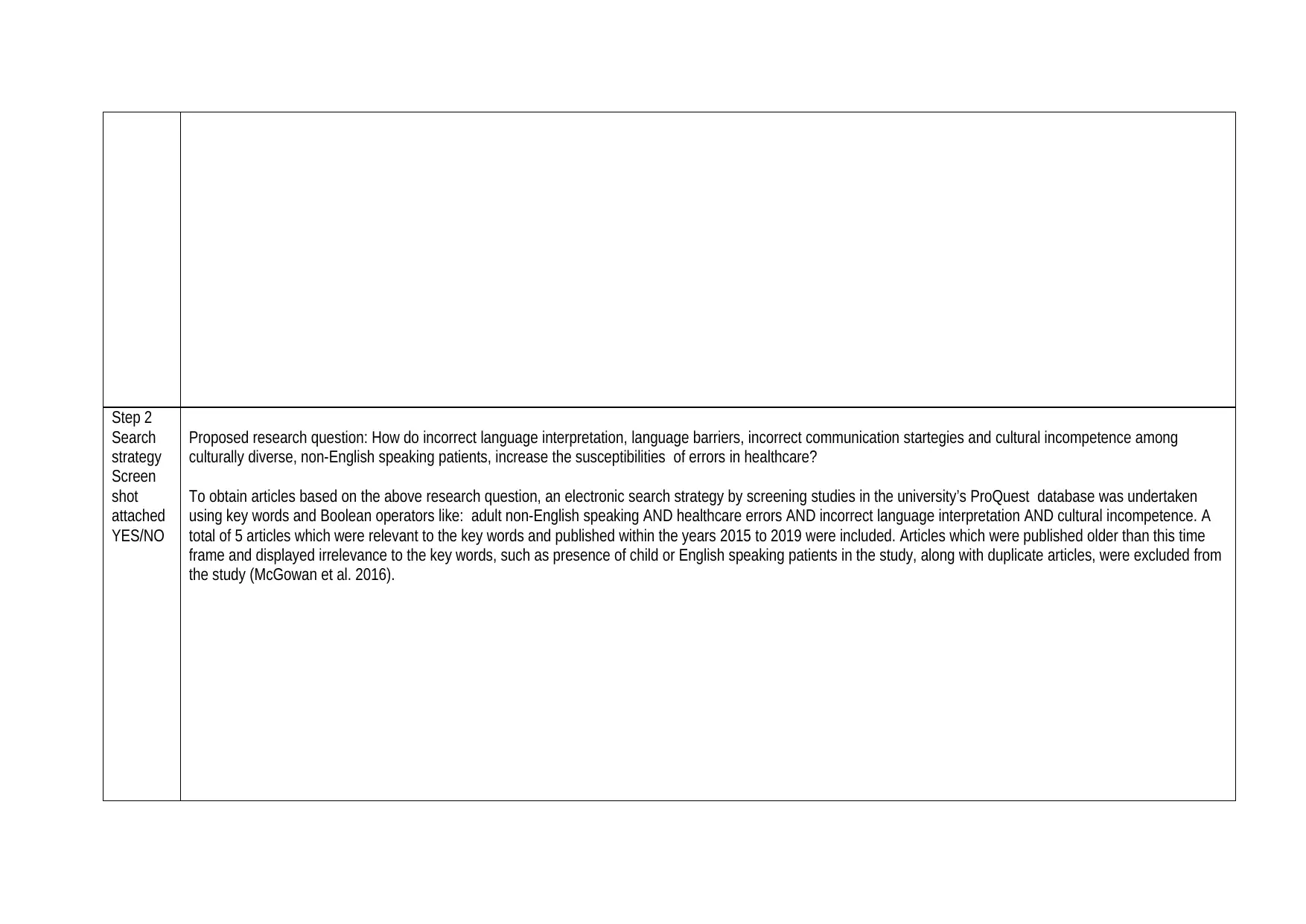
Step 2
Search
strategy
Screen
shot
attached
YES/NO
Proposed research question: How do incorrect language interpretation, language barriers, incorrect communication startegies and cultural incompetence among
culturally diverse, non-English speaking patients, increase the susceptibilities of errors in healthcare?
To obtain articles based on the above research question, an electronic search strategy by screening studies in the university’s ProQuest database was undertaken
using key words and Boolean operators like: adult non-English speaking AND healthcare errors AND incorrect language interpretation AND cultural incompetence. A
total of 5 articles which were relevant to the key words and published within the years 2015 to 2019 were included. Articles which were published older than this time
frame and displayed irrelevance to the key words, such as presence of child or English speaking patients in the study, along with duplicate articles, were excluded from
the study (McGowan et al. 2016).
Search
strategy
Screen
shot
attached
YES/NO
Proposed research question: How do incorrect language interpretation, language barriers, incorrect communication startegies and cultural incompetence among
culturally diverse, non-English speaking patients, increase the susceptibilities of errors in healthcare?
To obtain articles based on the above research question, an electronic search strategy by screening studies in the university’s ProQuest database was undertaken
using key words and Boolean operators like: adult non-English speaking AND healthcare errors AND incorrect language interpretation AND cultural incompetence. A
total of 5 articles which were relevant to the key words and published within the years 2015 to 2019 were included. Articles which were published older than this time
frame and displayed irrelevance to the key words, such as presence of child or English speaking patients in the study, along with duplicate articles, were excluded from
the study (McGowan et al. 2016).
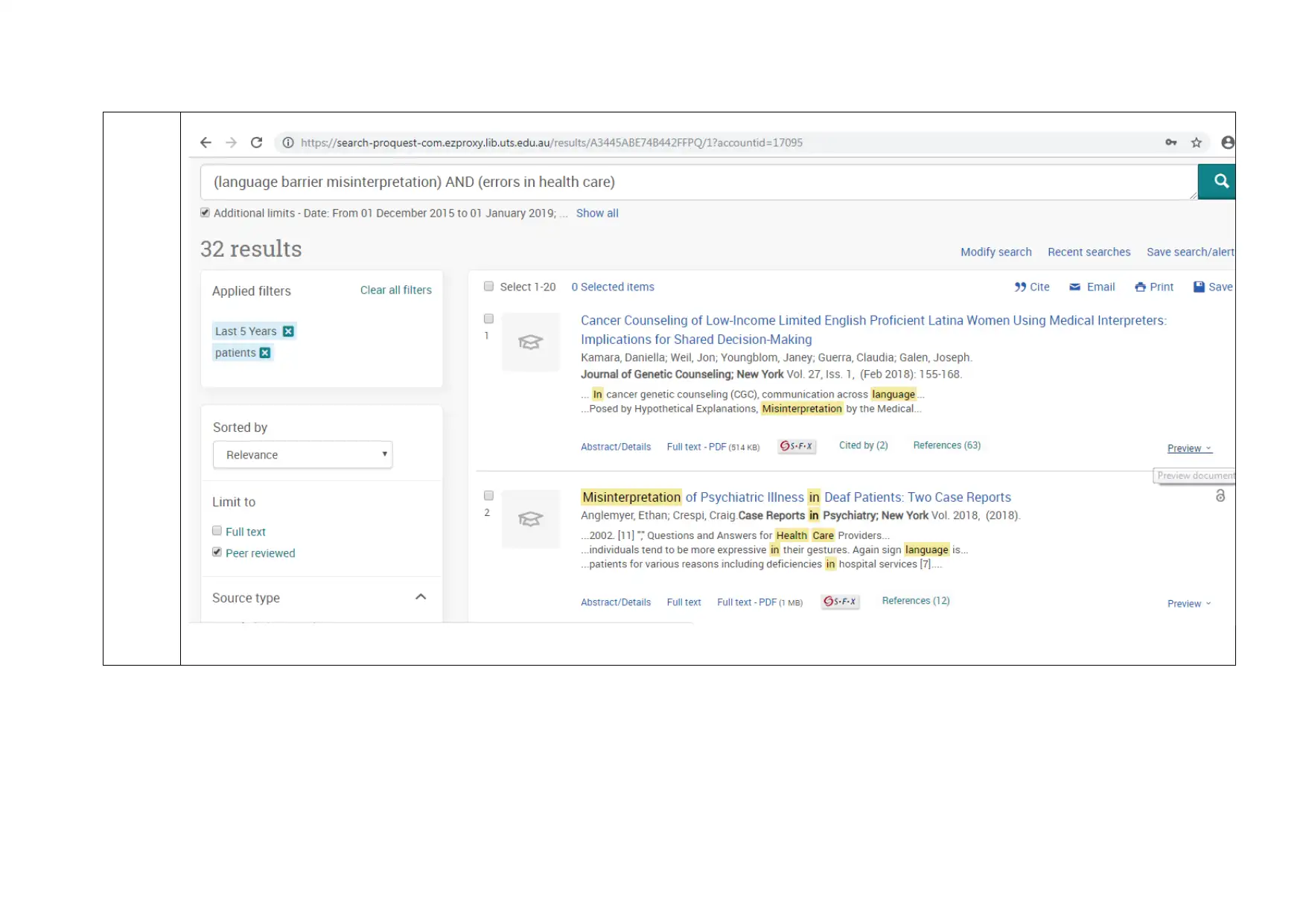
⊘ This is a preview!⊘
Do you want full access?
Subscribe today to unlock all pages.

Trusted by 1+ million students worldwide
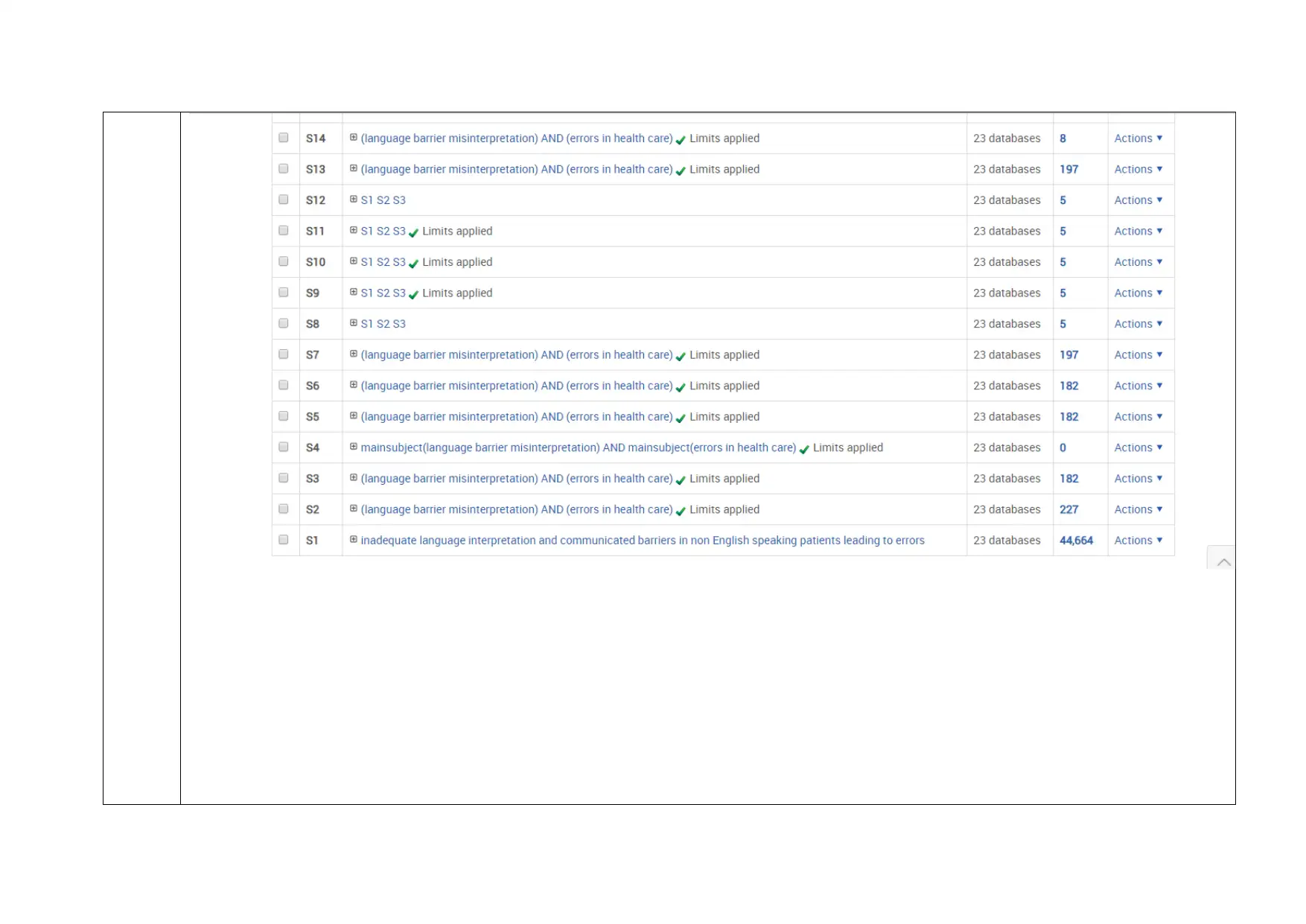
Paraphrase This Document
Need a fresh take? Get an instant paraphrase of this document with our AI Paraphraser
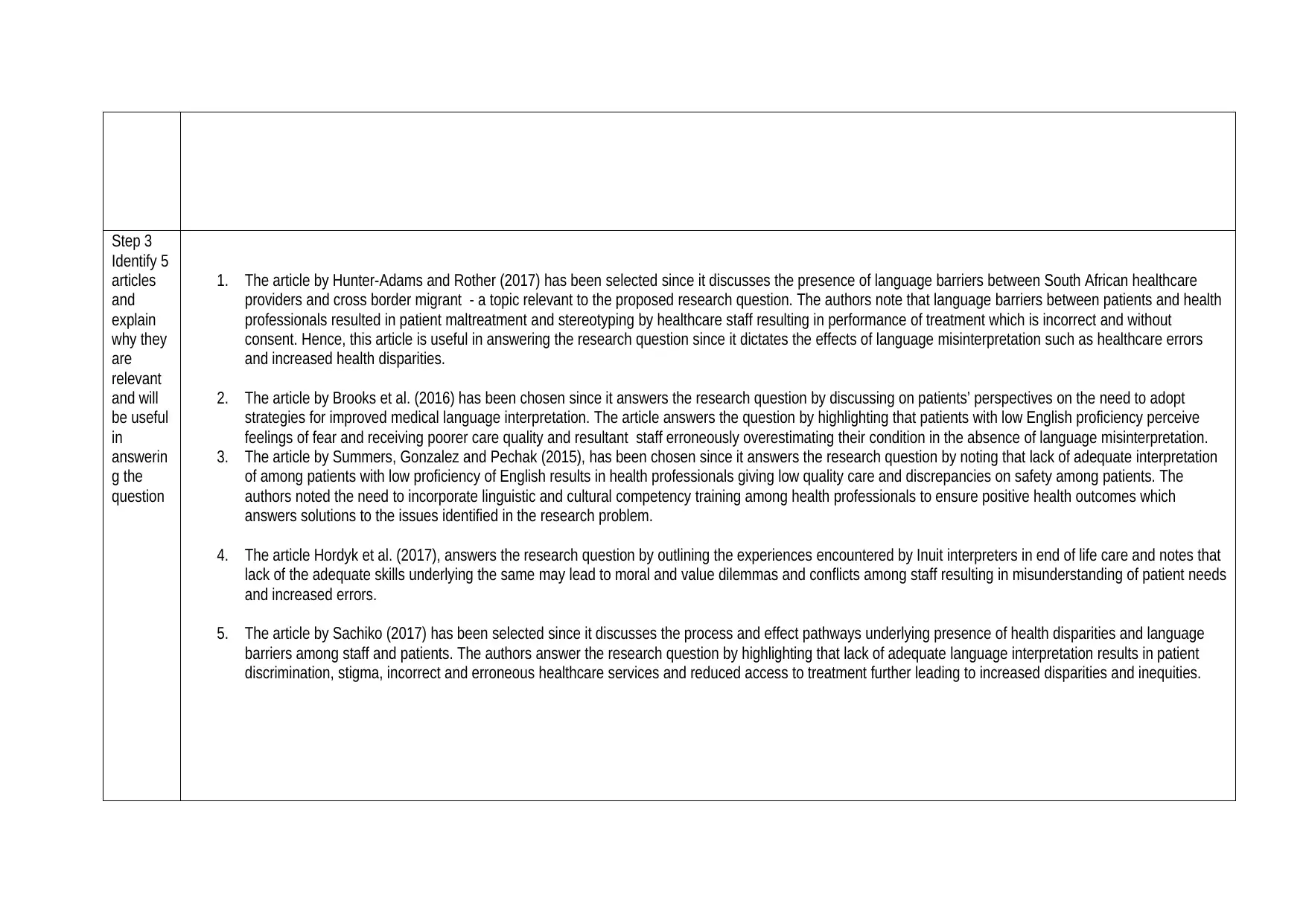
Step 3
Identify 5
articles
and
explain
why they
are
relevant
and will
be useful
in
answerin
g the
question
1. The article by Hunter-Adams and Rother (2017) has been selected since it discusses the presence of language barriers between South African healthcare
providers and cross border migrant - a topic relevant to the proposed research question. The authors note that language barriers between patients and health
professionals resulted in patient maltreatment and stereotyping by healthcare staff resulting in performance of treatment which is incorrect and without
consent. Hence, this article is useful in answering the research question since it dictates the effects of language misinterpretation such as healthcare errors
and increased health disparities.
2. The article by Brooks et al. (2016) has been chosen since it answers the research question by discussing on patients’ perspectives on the need to adopt
strategies for improved medical language interpretation. The article answers the question by highlighting that patients with low English proficiency perceive
feelings of fear and receiving poorer care quality and resultant staff erroneously overestimating their condition in the absence of language misinterpretation.
3. The article by Summers, Gonzalez and Pechak (2015), has been chosen since it answers the research question by noting that lack of adequate interpretation
of among patients with low proficiency of English results in health professionals giving low quality care and discrepancies on safety among patients. The
authors noted the need to incorporate linguistic and cultural competency training among health professionals to ensure positive health outcomes which
answers solutions to the issues identified in the research problem.
4. The article Hordyk et al. (2017), answers the research question by outlining the experiences encountered by Inuit interpreters in end of life care and notes that
lack of the adequate skills underlying the same may lead to moral and value dilemmas and conflicts among staff resulting in misunderstanding of patient needs
and increased errors.
5. The article by Sachiko (2017) has been selected since it discusses the process and effect pathways underlying presence of health disparities and language
barriers among staff and patients. The authors answer the research question by highlighting that lack of adequate language interpretation results in patient
discrimination, stigma, incorrect and erroneous healthcare services and reduced access to treatment further leading to increased disparities and inequities.
Identify 5
articles
and
explain
why they
are
relevant
and will
be useful
in
answerin
g the
question
1. The article by Hunter-Adams and Rother (2017) has been selected since it discusses the presence of language barriers between South African healthcare
providers and cross border migrant - a topic relevant to the proposed research question. The authors note that language barriers between patients and health
professionals resulted in patient maltreatment and stereotyping by healthcare staff resulting in performance of treatment which is incorrect and without
consent. Hence, this article is useful in answering the research question since it dictates the effects of language misinterpretation such as healthcare errors
and increased health disparities.
2. The article by Brooks et al. (2016) has been chosen since it answers the research question by discussing on patients’ perspectives on the need to adopt
strategies for improved medical language interpretation. The article answers the question by highlighting that patients with low English proficiency perceive
feelings of fear and receiving poorer care quality and resultant staff erroneously overestimating their condition in the absence of language misinterpretation.
3. The article by Summers, Gonzalez and Pechak (2015), has been chosen since it answers the research question by noting that lack of adequate interpretation
of among patients with low proficiency of English results in health professionals giving low quality care and discrepancies on safety among patients. The
authors noted the need to incorporate linguistic and cultural competency training among health professionals to ensure positive health outcomes which
answers solutions to the issues identified in the research problem.
4. The article Hordyk et al. (2017), answers the research question by outlining the experiences encountered by Inuit interpreters in end of life care and notes that
lack of the adequate skills underlying the same may lead to moral and value dilemmas and conflicts among staff resulting in misunderstanding of patient needs
and increased errors.
5. The article by Sachiko (2017) has been selected since it discusses the process and effect pathways underlying presence of health disparities and language
barriers among staff and patients. The authors answer the research question by highlighting that lack of adequate language interpretation results in patient
discrimination, stigma, incorrect and erroneous healthcare services and reduced access to treatment further leading to increased disparities and inequities.
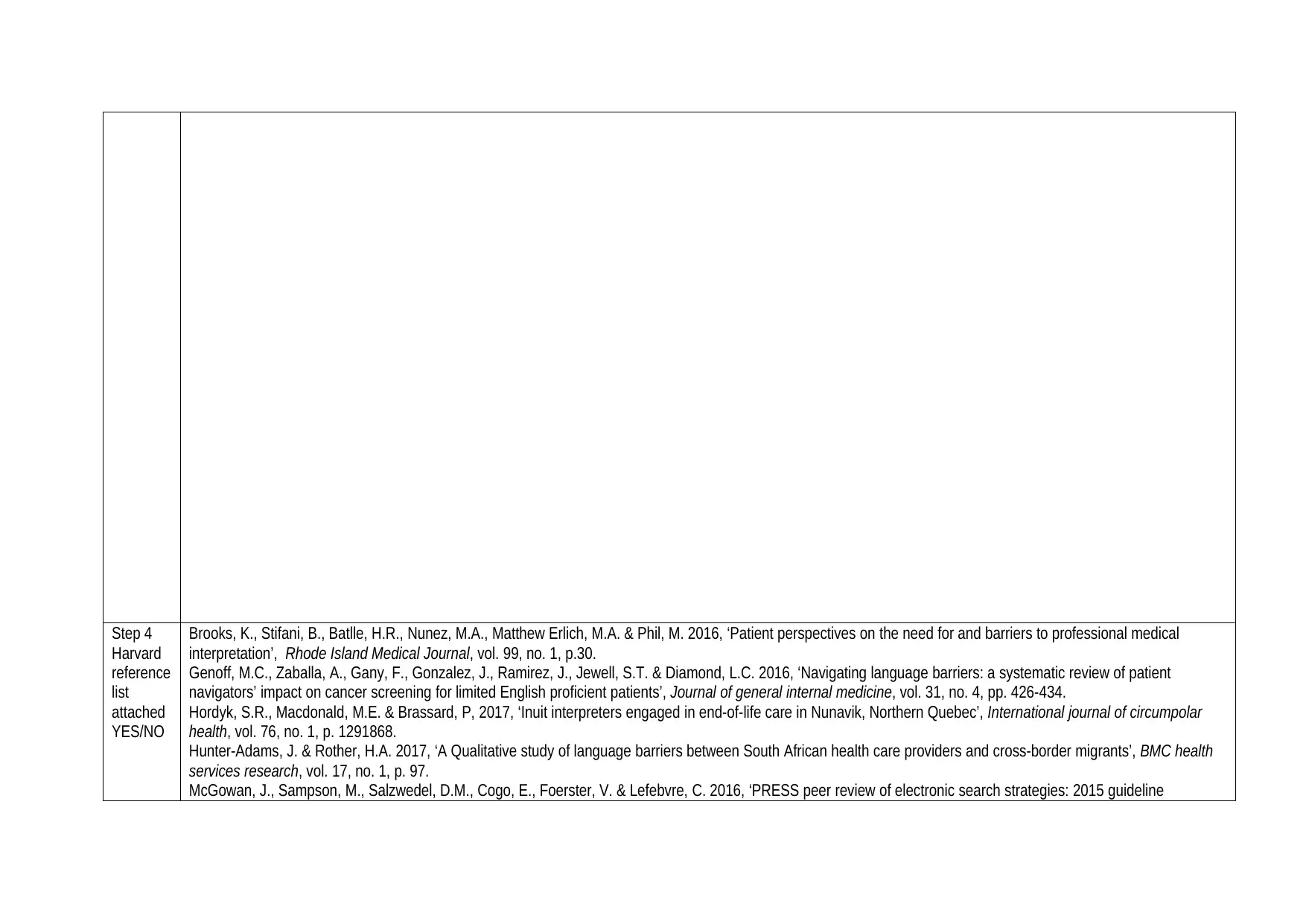
Step 4
Harvard
reference
list
attached
YES/NO
Brooks, K., Stifani, B., Batlle, H.R., Nunez, M.A., Matthew Erlich, M.A. & Phil, M. 2016, ‘Patient perspectives on the need for and barriers to professional medical
interpretation’, Rhode Island Medical Journal, vol. 99, no. 1, p.30.
Genoff, M.C., Zaballa, A., Gany, F., Gonzalez, J., Ramirez, J., Jewell, S.T. & Diamond, L.C. 2016, ‘Navigating language barriers: a systematic review of patient
navigators’ impact on cancer screening for limited English proficient patients’, Journal of general internal medicine, vol. 31, no. 4, pp. 426-434.
Hordyk, S.R., Macdonald, M.E. & Brassard, P, 2017, ‘Inuit interpreters engaged in end-of-life care in Nunavik, Northern Quebec’, International journal of circumpolar
health, vol. 76, no. 1, p. 1291868.
Hunter-Adams, J. & Rother, H.A. 2017, ‘A Qualitative study of language barriers between South African health care providers and cross-border migrants’, BMC health
services research, vol. 17, no. 1, p. 97.
McGowan, J., Sampson, M., Salzwedel, D.M., Cogo, E., Foerster, V. & Lefebvre, C. 2016, ‘PRESS peer review of electronic search strategies: 2015 guideline
Harvard
reference
list
attached
YES/NO
Brooks, K., Stifani, B., Batlle, H.R., Nunez, M.A., Matthew Erlich, M.A. & Phil, M. 2016, ‘Patient perspectives on the need for and barriers to professional medical
interpretation’, Rhode Island Medical Journal, vol. 99, no. 1, p.30.
Genoff, M.C., Zaballa, A., Gany, F., Gonzalez, J., Ramirez, J., Jewell, S.T. & Diamond, L.C. 2016, ‘Navigating language barriers: a systematic review of patient
navigators’ impact on cancer screening for limited English proficient patients’, Journal of general internal medicine, vol. 31, no. 4, pp. 426-434.
Hordyk, S.R., Macdonald, M.E. & Brassard, P, 2017, ‘Inuit interpreters engaged in end-of-life care in Nunavik, Northern Quebec’, International journal of circumpolar
health, vol. 76, no. 1, p. 1291868.
Hunter-Adams, J. & Rother, H.A. 2017, ‘A Qualitative study of language barriers between South African health care providers and cross-border migrants’, BMC health
services research, vol. 17, no. 1, p. 97.
McGowan, J., Sampson, M., Salzwedel, D.M., Cogo, E., Foerster, V. & Lefebvre, C. 2016, ‘PRESS peer review of electronic search strategies: 2015 guideline
⊘ This is a preview!⊘
Do you want full access?
Subscribe today to unlock all pages.

Trusted by 1+ million students worldwide

statement’, Journal of clinical epidemiology, vol. 75, pp. 40-46.
Nápoles, A.M., Santoyo-Olsson, J., Karliner, L.S., Gregorich, S.E. & Pérez-Stable, E.J. 2015, ‘Inaccurate language interpretation and its clinical significance in the
medical encounters of Spanish-speaking Latinos’, Medical care, vol. 53, no. 11, p. 940.
Summers, C., Gonzalez, E. & Pechak, C. 2015, ‘How should we prepare rehabilitation sciences students to work with low English-proficient Spanish-speaking
patients?’, Journal of allied health, vol. 44, no. 2, pp.17E-21E.
Terui, S. 2017, ‘Conceptualizing the pathways and processes between language barriers and health disparities: review, synthesis, and extension’, Journal of immigrant
and minority health, vol. 19, no. 1, pp. 215-224.
REFERENCE LIST
Nápoles, A.M., Santoyo-Olsson, J., Karliner, L.S., Gregorich, S.E. & Pérez-Stable, E.J. 2015, ‘Inaccurate language interpretation and its clinical significance in the
medical encounters of Spanish-speaking Latinos’, Medical care, vol. 53, no. 11, p. 940.
Summers, C., Gonzalez, E. & Pechak, C. 2015, ‘How should we prepare rehabilitation sciences students to work with low English-proficient Spanish-speaking
patients?’, Journal of allied health, vol. 44, no. 2, pp.17E-21E.
Terui, S. 2017, ‘Conceptualizing the pathways and processes between language barriers and health disparities: review, synthesis, and extension’, Journal of immigrant
and minority health, vol. 19, no. 1, pp. 215-224.
REFERENCE LIST
1 out of 7
Related Documents
Your All-in-One AI-Powered Toolkit for Academic Success.
+13062052269
info@desklib.com
Available 24*7 on WhatsApp / Email
![[object Object]](/_next/static/media/star-bottom.7253800d.svg)
Unlock your academic potential
Copyright © 2020–2025 A2Z Services. All Rights Reserved. Developed and managed by ZUCOL.





